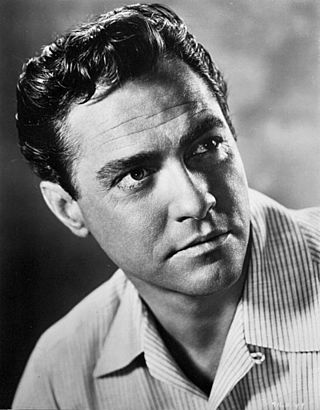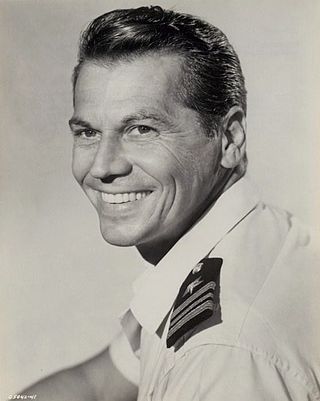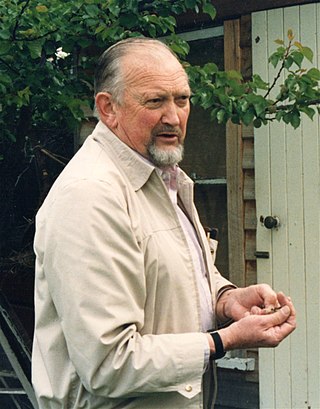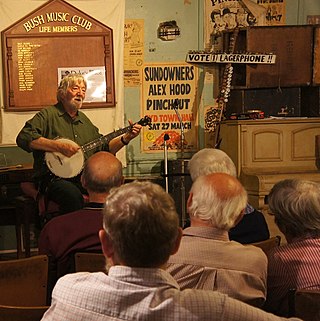Related Research Articles

Richard Andrew Palethorpe-Todd was an Irish-British actor known for his leading man roles of the 1950s. He received a Golden Globe Award for Most Promising Newcomer – Male, and an Academy Award for Best Actor nomination and a Golden Globe Award for Best Actor nomination for his performance as Corporal Lachlan MacLachlan in the 1949 film The Hasty Heart. His other notable roles include Jonathan Cooper in Stage Fright (1950), Wing Commander Guy Gibson in The Dam Busters (1955), Sir Walter Raleigh in The Virgin Queen (1955), and Major John Howard in The Longest Day (1962). He was previously a Captain in the British Army during World War II, fighting in the D-Day landings as a member of the 7th Parachute Battalion.

Frederick George Peter Ingle Finch was an English-Australian actor of theatre, film and radio.

Grafton is a city in the Northern Rivers region of the Australian state of New South Wales. It is located on the Clarence River, on a floodplain, approximately 608 kilometres (378 mi) by road north-northeast of the state capital Sydney.

Jedda, released in the UK as Jedda the Uncivilised, is a 1955 Australian film written, produced and directed by Charles Chauvel. His last film, it is notable for being the first to star two Aboriginal actors, Robert Tudawali and Ngarla Kunoth in the leading roles. It was also the first Australian feature film to be shot in colour.

Diana Dors was an English actress and singer.

Frank William George Lloyd was a British-born American film director, actor, scriptwriter, and producer. He was among the founders of the Academy of Motion Picture Arts and Sciences, and was its president from 1934 to 1935.

Ronald Egan Randell was an Australian actor. After beginning his acting career on the stage in 1937, he played Charles Kingsford Smith in the film Smithy (1946). He also had roles in Bulldog Drummond at Bay (1947), Kiss Me Kate (1953), I Am a Camera (1955), Most Dangerous Man Alive (1961) and King of Kings (1961).

Nigel Patrick was an English actor and stage director born into a theatrical family.

Cecil Lauriston Kellaway was a South African character actor. He was nominated for the Academy Award for Best Supporting Actor twice, for The Luck of the Irish (1948) and Guess Who's Coming to Dinner (1967).

The New Theatre, formerly Workers' Art Club and New Theatre League, is a community theatre company in the Inner West Sydney suburb of Newtown, Australia. Its origins are in the international New Theatre movement of the 1920s, and it is the oldest theatre company in continuous production in New South Wales.

Francis Prout Mahony, also known as Frank Mahony, was an Australian painter, watercolorist and illustrator. Although christened "Francis Mahony", he later added "Prout" and usually signed his work as "Frank P. Mahony". It is apparently unknown why he chose to add "Prout".

John Stanley Raymond Meredith OAM was an Australian pioneer folklorist from Holbrook, New South Wales whose work influenced the Australian folk music revival of the 1950s, in particular as a founding member of the Australia's first revivalist bush band The Bushwhackers. He was awarded the Medal of the Order of Australia in 1986 for service to Australian folklore and music, and became a Member of the Order of Australia in 1992 for service to the Arts, particularly in the collection and preservation of Australian folklore.

Alexander Stewart Ferguson "Alex" Hood is an Australian folk singer, writer, actor, children's entertainer/educator and folklorist.

Francis William Thring III, better known as F. W. Thring, was an Australian film director, producer, and exhibitor. He has been credited with the invention of the clapperboard.
Reedy River is a 1953 Australian folk musical about the 1891 Australian shearers' strike. The libretto was written by Dick Diamond with songs chosen by John Gray. Two new songs were written for the musical by Diamond with music by Miles Maxwell.
The Torrents is a 1955 Australian play by Oriel Gray, set in the late 19th century, about the arrival of a female journalist in an all-male newspaper office, and an attempt to develop irrigation-based agriculture in a former gold mining town.

The Bushwhackers, initially named "The Heathcote Bushwhackers", Australia's first "revival" bush band were arguably the catalyst for Australia's folk revival of the 1950s; prior to that revival, similar bush bands, utilizing a mixture of commercially available and sometimes home-made instruments, had performed a social function in rural areas since the late 19th century. The Bushwhackers performed from 1952 to 1957, when founder John Meredith disbanded the group and its members dispersed into other activities.. Over its relatively brief existence, the group evolved from an initial novelty act to one with a more serious mission of presenting and promoting to Australia its neglected bush song heritage, and laid the foundation for similar groups to follow through the 1960s and to the present. Its members also operated—at least initially—from a Marxist / Australian Communist Party ideology, attempting to embody the struggle of the working class against the ruling classes, although this may have been less than obvious to their audiences under the guise of popular entertainment.
Nigel Tasman Lovell was an Australian stage, radio, film and television actor, and producer of opera and both stage and radio drama.

Minnie Everett was an Australian ballet-mistress and producer, closely associated with the J. C. Williamson's company. She was the world's first woman producer of Gilbert and Sullivan operettas.
Richard Frank Diamond, better known as Dick Diamond, was an Australian writer best known for Reedy River.
References
- ↑ "WHAT'S ON". Tribune . No. 967. New South Wales, Australia. 3 October 1956. p. 12. Retrieved 28 August 2023– via National Library of Australia.
- ↑ Pinne, Peter (5 December 2015). "Queensland Sings". Theatre Heritage.
- ↑ "From Reedy River to Coolibah Tree". Tribune . No. 884. New South Wales, Australia. 2 March 1955. p. 8. Retrieved 28 August 2023– via National Library of Australia.
- ↑ Angela O'Brien, 'Diamond, Richard Frank (Dick) (1906–1989)', Australian Dictionary of Biography, National Centre of Biography, Australian National University, https://adb.anu.edu.au/biography/diamond-richard-frank-dick-12417/text22323, published first in hardcopy 2007, accessed online 28 August 2023.
- ↑ "A SHOW TO TAKE YOUR FRIENDS TO". Tribune . No. 970. New South Wales, Australia. 24 October 1956. p. 8. Retrieved 28 August 2023– via National Library of Australia.